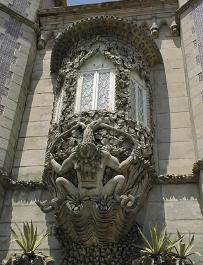
Lisboa (Lisbon)
July 13th - July 16th, 1999

They really are geared up for the pilgrim/tourist in Fatima as we caught what had to be the fastest bus ride of the trip to the capital of Portugal, the port city of Lisboa. The bus station was in a section of town way off our guide book map, but it was relatively easy for us to find a subway and head into the center of town. While not completely packed with tourists, Lisboa seems to be a favorite stopping point on the tourist circuit and we had to search for a while before finding a room. With modern facilities and very clean, our room also was in the direct daylight sun which tended to make it uncomfortable for afternoon siestas.
Lisboa is a relatively modern city. Part of this stems from the destruction of the earthquake of 1755, which flattened most of the city and killed 20% of its citizens. The city was rebuilt in the late 18th and 19th centuries, the avenues straightened, and the medieval feeling removed. One exception is the Alfama, the section of town built on the rocky hill surrounding the Castelo de São Jorge (below left). The Alfama has that funky, ancient feeling and is littered with little bars and restaurants. One of the more modern sights in Lisboa is the Ascensor De Santa Justa, an elevator encased in a Gothic wrought-iron tower. Built in 1902, it helps residents negotiate the hill to the Barrio Alto.
|
 |
Igreja de São Roque
At this point we were quickly approaching our fill of Portuguese churches, but we had to fit one more from the south to see what differences there may be. We choose the church of São Roque, dedicated to the Saint who is believed to have saved the Barrio Alto from devastation during the great earthquake. Not as run down as most Portuguese churches, we saw some of the finest carvings of the trip so far. Below left: an altar devoted to Mary, with a halo of attendant angels; middle, the painted (and in need of restoration) wooden roof of the church, and right a sample of the holy relics from a set of big display cases full of them.
|
|
|
The Waterfront
Much of the interesting architecture in Lisboa lies not in the city proper but in a suburb called Belém. We took a tram there and walked along the waterfront, enjoying the two magnificent towers there, the modern Pradrão dos Descobrimentos (below top left), and the older Torre de Belém - built in 1520 (below bottom right). We were too late to enter the Torre de Belém, but the view from the modern Pradrão more than made up for it. The square below was tiled with a giant compass set in a stylized ocean surrounding a map of the world, and this map showed which parts of the globe Portugal colonized and when.
|
|
|
|
We guess imitation is the sincerest form of flattery. The bridge spanning the Rio Tejo bears an uncanny resemblance to the Golden Gate bridge in San Francisco. Even the color is the same. A little of the art deco detailing is missing from the towers, and the bridge itself is longer but every other detail seemed to fit. We couldn't find out any information about the bridge (even when it was built), so it's anyone's guess why the Portuguese made such an exact copy.

Sintra
In order to escape the heat of the city, we made a day trip into the little mountainside town of Sintra. A destination for the 19th century chic, we found a very pleasant and cool fairyland of a place. To see all Sintra has to offer would take several days, so we just hit the high points. Our first stop was the Palácio Nacional da Pena. Built in the 1840s by Prince Ferdinand of Bavaria, it was meant to soothe his homesick soul and is a collision of Portuguese and Bavarian architecture. We found the detailing both intriguing and amusing -- proof that the prince didn't take himself too seriously. A real crowd pleaser is the man of the forest, supporting this window alcove (bottom right). Visitors are allowed to tour the castle's interior and view the opulence the prince and his bride Queen Maria II allowed themselves to live in. There was a very strict no camera policy, but we did manage to sneak a good shot of the kitchen.
|
 |
|
On a hill opposite the castle stand the remains of a 16th century Moor fortress, the Castelo dos Mouros. Built when the Moors occupied southern Iberia, it's in amazingly good shape and offers a wonderful vantage point to view the town and valley. Especially interesting are the hidey-holes (bottom right), where Moor soldiers would hide themselves and spring out to surprise any attacker from behind.
|
|
|
Our find in Lisboa
Always on the prowl for good Indian food, we learned of a Goa-style restaurant in the Alfama right across from the gates leading to the Castelo de São Jorge. Goa was once a colony of Portugal, so we thought this could be good. We're happy to report the fish curry was excellent and nicely spiced (a welcome change from the bland Portuguese palette) and our introduction Goan nan gave us both a chuckle. And the owner is a very friendly chap who speaks excellent English.
